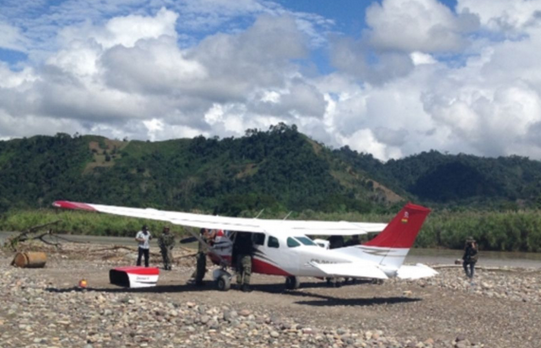
President Ollanta Humala is backing legislation that was approved in Congress last week that would allow the Armed Forces to intercept suspected drug trafficking airplanes, and shoot them down if they refuse to obey orders to land.
“I think it is a positive issue because it is going to be a deterrent against any drug planes that want to enter Peruvian territory,” Humala said in comments picked up by daily El Comercio.
Since about 2010, Peruvian anti-drug police and analysts have seen an uptick in the number of small aircraft that fly in and out of Peru’s coca growing valleys to pick up coca paste and cocaine. The planes come mainly from Bolivia, landing in the valleys of the Apurimac and Ene rivers, which with the Mantaro river valley are known strategically as the VRAEM.
In Februry this year, the anti-drug agency Devida’s director, Alberto Otárola, announced that the VRAEM area was to become a no-fly zone.
The VRAEM is the world’s top coca growing region, accounting for almost 70% of all coca leaves produced in the country. The area straddles the south-central regions of Cusco, Ayacucho, Huancavelica and Junin.
Peru used to practice flight interdiction in the late 1990s with assistance from the United States’ Drug Enforcement Administration, DEA, helping to curb an aerial corridor used by traffickers to smuggle cocaine from Peru to Colombia. But the government halted the policy following the accidental shooting of a small aircraft carrying an American missionary family, killing the mother and a toddler. The aircraft had been mistakenly identified as a possible drug flight by DEA pilots, who relayed the information to the Peruvian air force to shoot the plane down when the pilot did not respond to orders to land.
Officials in President Ollanta Humala’s administration have said it is necessary to restart the program now due to the increased number of aircraft flying in daily to move cocaine from Peru to Bolivia. From there, the cocaine is taken to Brazil, Argentina or another South American country, where some is consumed but most is shipped abroad, often to Europe. A recent shipment of cocaine that was seized at a port in Italy had been shipped from Argentina.
The frequency of the flights into the area make the makeshift airstrips at “Santa Rosa, Mayapo and Llochegua seem like the Jorge Chavez International Airport” according to a specialist in the police force, quoted in a series of special reports by investigative journalist Gustavo Gorriti last year in IDL-Reporteros.
Peru’s government says the measure is necessary in order to protect national security. It said there are concerns about the possibility of the planes bringing in weapons to the VRAEM, where a splinter group of the Shining Path rebels operates as protection to growers and traffickers.
U.S. officials in Lima are critical of any plans to restart the flight interdiction program, saying that it would break international aviation law. There is also a fear of new mistakes if intelligence and communications are not fully clear.





